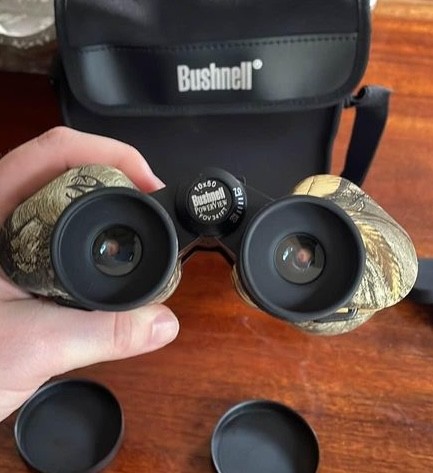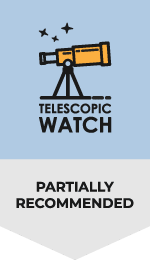

Optics
The PowerView 10x50s utilize standard 50mm (2 inch) diameter achromatic doublet objective lenses made of crown and flint glass. Owing to their fast focal ratio, which is approximately f/4, they generate noticeable chromatic aberration. However, at 10x magnification, this isn’t extremely evident, and the lenses are fairly sharp, producing clear images across the field.
One drawback is that the prisms in the PowerView 10x50s are made of BK7 glass, which is a more affordable and lower quality option often found in budget optics. BK7 glass tends to produce more scatter compared to the higher quality BAK-4 glass, which is found in more premium binoculars. Additionally, it appears that the multi-coatings applied to the objective lenses are absent on the prisms, which somewhat reduces light transmission and sharpness. On the positive side, the prisms are adequately sized and do not cause vignetting, ensuring that users get the full 50mm aperture.
The Bushnell PowerView 10×50 binoculars feature an apparent field of view of 65° at the eyepiece, which corresponds to a 6.5° true field at 10x magnification. This is commonly expressed as 341 feet at 1,000 yards. This specification is typical for a pair of 10×50 binoculars, and the 65° apparent field is quite immersive, though not as encompassing as that of eyepieces with ultra-wide angles.
However, the affordability of the PowerView 10x50s comes with some compromises in the optical design of the eyepieces. There is noticeable distortion towards the outer edges of the field of view, approximately in the last 15%. Aside from this distortion, the view is fairly sharp, with the exception of chromatic aberration. This manifests as bluish or purplish halos around bright objects such as the moon, planets, and stars of about second magnitude or brighter.
In terms of light-gathering capability, the 50mm aperture of the PowerView 10x50s is comparable to that of a 3 to 4-inch telescope. They can’t provide detailed views of the moon, planets, or double stars as they are fixed at 10x magnification, but they offer a wide field of view, which can be advantageous for observing larger objects or scenes.
Mechanics
The eyepieces of the PowerView 10x50s offer only 10mm of eye relief, which makes them less comfortable for eyeglass wearers, even with the eye cups rolled down. There is, however, a diopter adjustment on the right side, which can be used to compensate for differences in focus between the left and right eyes.
Focusing the PowerView 10x50s is achieved by adjusting a center knob, which is shaped more like a toggle lever than a round knob. Bushnell markets this as their “InstaFocus” technology, but it doesn’t offer any significant advantages. It’s important not to mistake the PowerView binoculars for Bushnell’s “PermaFocus” line, which lacks focus adjustments and is of very low quality. The PermaFocus binoculars are best avoided.
Occasionally, the PowerView 10x50s may arrive mis-collimated, or they may become so if dropped. This necessitates sending them back to the manufacturer for servicing unless you are proficient in collimating binoculars. One advantage is that there is minimal rubber armor concealing the collimation screws, which could make self-repair more accessible. However, the downside to the lack of substantial rubber armor is that these binoculars are not waterproof and are not particularly durable. While thin rubber armor can protect against a mild drop, a fall from a significant height could render them unusable. Moreover, even a small drop can cause severe mis-collimation.
As with most binoculars, the PowerView 10x50s can be attached to a tripod by removing a small central cap and using a tripod adapter.
Mounting Recommendations
While many individuals can hold 10×50 binoculars steady, some may benefit from mounting them on a tripod or monopod for enhanced stability. We generally recommend using a monopod for these binoculars due to its convenience and portability. Alternatively, a parallelogram mount can be used, though this option might seem excessively expensive compared to the relatively inexpensive 10×50 binoculars. Regardless of the mounting solution you choose, a metal tripod adapter is needed to attach the binoculars to a 1/4-20 stud.
Related Product Guide: Best Mounting for Astronomy Binoculars
Should I buy Used Bushnell PowerView 10×50 Binoculars?
When considering purchasing a used pair of binoculars, the main concern is potential damage or misalignment of the internal prisms. If you are unable to test them in person, there’s a risk of receiving a pair with misaligned prisms. Learning to adjust and correct this issue can be a tedious and frustrating process. If you’re in the market for used 10×50 binoculars, it’s possible to find better options at comparable or lower prices than a used pair of PowerView 10x50s.
Alternative Recommendations
The Bushnell PowerView 10x50s are decent for basic usage, but they are not the best in their price range. For those looking for alternative binoculars that might offer better value or quality, there are a few options. Other 10×50 binoculars with superior prisms and optics or a wider field of view might be a better choice. Enhanced prisms and optics typically result in better image quality. If stability is a concern or if you prefer a wider field of view, 7×50 binoculars can be an option. They offer a steadier and often wider view, though the brighter background they produce may be less desirable under light-polluted skies.
For those looking to observe deep-sky objects, larger binoculars with 60mm apertures are popular and still manageable for handheld use. Giant binoculars in the 70mm to 80mm range can be used on tripods and offer deep-sky viewing capabilities comparable to those of small telescopes.
Here are a few of our top picks for all of the aforementioned categories, sorted by price.
Under $75
- The Celestron SkyMaster 12x60s are commendably larger aperture units. They can still be used handheld for some people, though due to the 12x magnification, they might be a little shaky and are best used with a monopod or tripod. The 12x60s do not have the quality control issues that are often associated with the larger SkyMaster 15x70s, and the views are substantially brighter than what you would get with a 50mm binocular.
- The SVBONY SV206 10×50 binoculars offer a significantly wider field of view compared to the Bushnell PowerView 10x50s and most other 10×50 binoculars, at 7.5°. They are also relatively affordable. However, there are trade-offs in terms of durability and optical quality. These binoculars exhibit a loss of sharpness towards the edges of the field, which may make them not the best choice for those seeking high optical quality.
- Celestron Cometron 7×50. These binoculars have BK7 prisms, which are somewhat undersized and reduce the effective aperture. Despite this, they are a good option for those seeking a very low-cost pair of binoculars. As an alternative, the Celestron UpClose G2 10x50s have less vignetting compared to the Cometron 7x50s, and they offer the same 10x magnification as the Bushnell PowerView 10x50s.
Over $75
- The Bushnell Legacy WP 10x50s are a step up in quality, offering sharper images and better eye relief compared to the PowerView 10x50s. They are also fully waterproof and fog-resistant. Their twist-up eyecups are simpler to use and more comfortable compared to the basic roll-up eyecups found on more affordable binoculars.
- The Nikon Aculon 10×50 binoculars are another worthy consideration. While they do not boast the widest field of view, they are durable and rugged, with extremely sharp optics. They also offer generous eye relief with twist-up eyecups, similar to the Bushnell Legacy WP 10x50s.
- The Celestron SkyMaster 15x70s are an option for those seeking larger aperture binoculars. These binoculars have a larger aperture compared to the Bushnell PowerView 10x50s and feature superior BAK-4 prisms. However, due to their larger size and higher magnification, it is practically a necessity to use a tripod or monopod for stabilization. Additionally, there have been some quality control issues with these binoculars, especially regarding collimation. They may arrive mis-collimated or become mis-collimated shortly after use. This is an issue that can be fixed by the user if need be, but it often simply necessitates a return to the factory, which can be costly and time-consuming.
- The Zhumell 12×70 Astronomy Binoculars don’t suffer from collimation or other quality issues quite as much as the SkyMaster 15x70s, are steadier at 12x, and offer a slightly wider field of view – but are equally bulky/heavy on account of sharing the same basic design.
What can you see?
The PowerView 10x50s are excellent for observing open star clusters and large deep-sky objects, particularly in regions of the Milky Way such as Sagittarius, Cygnus, and Scorpius. You can see objects like the North American Nebula, Pelican Nebula, Rosette Nebula, Cygnus Star Cloud, various open clusters in Canis Major, and many more. Nebulae like Orion and Lagoon are bright enough to be seen even from areas with moderate light pollution.
Open star clusters such as M35 and M11 are delightful to observe through these binoculars under almost any sky. However, globular clusters cannot be resolved into individual stars, and planets are indistinct due to the limited aperture and 10x magnification. Exceptions include the Dumbbell Nebula, which can be seen as a faint smudge under dark skies, and Omega Centauri, which might be vaguely resolved into individual stars if you are located at a latitude where the cluster is visible. However, if you are observing from a location with significant light pollution, many of the aforementioned deep-sky objects that are ideally observed with binoculars may become washed out and hard to see.
Galaxies are mostly too small and dim to see in detail with 10×50 binoculars, especially if you are observing from an area with light pollution. However, you should be able to see the dust lanes in the Andromeda Galaxy, as well as groups like the Leo Triplet, M82 and M81, the Virgo Cluster, and the satellite galaxies of Andromeda (M31).
In addition to observing deep-sky objects, the PowerView 10x50s can also be used for observing widely-separated double or multiple stars such as Mizar/Alcor or Albireo. However, the experience might not be as thrilling compared to using a telescope, where you can change the magnification to split the stars.
Within our solar system, the PowerView 10x50s can reveal craters and large geological features on the Moon, including the lunar maria (seas) and other formations. When the Moon is in a waxing crescent phase, the light of the Earth reflecting off the unlit portion of the Moon, known as earthshine, is visible. The phases of Venus can usually be seen through the PowerView 10x50s if you can hold them steady. Mars appears as a tiny dot with no discernible detail, even at its largest and brightest. Jupiter’s disk is clear at 10x magnification, and you can see all four of its Galilean moons: Io, Europa, Ganymede, and Callisto. Saturn appears somewhat oval-shaped but without clearly defined rings; its moon Titan is visible nearby. Uranus and Neptune are visible through the PowerView 10x50s even from suburban skies, but they do not show any discernible features.

